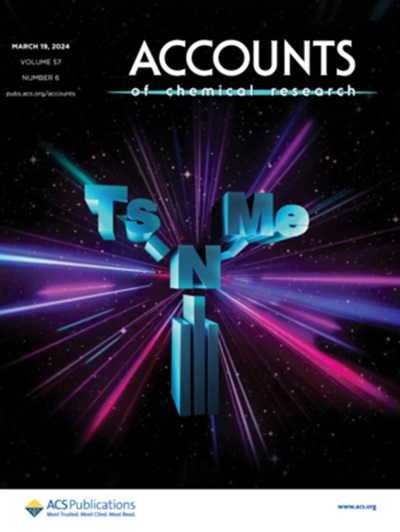用于生物正交催化的设计器纳米反应器
摘要
分区生物结构(如细胞和细胞器)的进化复杂性赋予了维持生命的多级化学级联和错综复杂的生命功能。相对而言,在很短的时间内,合成范式在不同长度尺度(分子、纳米、微米和宏观)的材料控制方面取得了巨大发展,提高了对机理的理解,并将设计原则设定为不同的组成、构型和结构,进而微调其光电和催化特性,以实现目标应用。生物正交催化为生物化学调控提供了一个用途广泛的工具包,并能在生物系统内进行新的自然反应,赋予增强功能。然而,由于生物环境恶劣,传统催化剂在生理条件下控制反应存在局限性。本报告详细介绍了生物适用的多组分设计型纳米反应器(NRs)的开发情况,不同金属纳米催化剂的成分、形态、界面活性位点以及周围的微环境可通过新型纳米空间封闭化学方法进行精确控制。多孔、中空和开口硅基纳米外壳的不同结构有助于容纳、保护和选择性访问不同的纳米级金属催化位点。二氧化硅的模块化多孔性/组成、光学透明性、隔热性和无毒性非常有用。此外,酶(用于化学酶级联)和选择性增强剂(用于刺激响应门控)也可与金属纳米催化剂一起占据大孔或空腔。此外,利用可远程操作的生物兼容能源选择性地激活和控制催化反应至关重要。高度耦合的等离子体(Au)元件具有几纳米的结构特征(间隙、空腔和作为电磁热点的结点),因此可以有效地利用低功率近红外光,并通过局部光热和电子效应选择性地向界面催化位点提供能量。不同的等离子集成 NR 具有可定制的等离子催化元件、双层纳米空间内的空腔以及中空二氧化硅内的金属层状纳米晶体,可以在包括活细胞在内的复杂介质中进行近红外/光诱导催化反应。此外,通过在中空多孔二氧化硅外壳内预先安装的超顺磁性氧化铁内核上选择性生长催化金属,磁热诱导 NRs 使 AMF 有机会作为一种生物正交刺激来促进催化反应。通过将 "质子催化 "和 "磁性催化 "元件结合到一个 NR 中,两个不同的反应步骤可以由两种能量机制不同的能源(近红外光和 AMF)进行理想的控制。与自然生命系统协调进行多步有机分子转化的能力将揭示细胞内合成活性药物和生物成像探针的新型反应方案。精心设计的纳米级离散 NR 结构可促进非生物化学合成的时空控制,而不会对细胞活力产生不利影响。然而,深入了解异质表面催化反应、速率诱导机制、选择性控制途径和有针对性的纳米生物相互作用是必要的。借助基于化学设计的新型纳米材料和合成具有独特生物正交化学功能的工程化 NR,生物医学工程这一广泛领域将受益匪浅。


The evolutionary complexity of compartmentalized biostructures (such as cells and organelles) endows life-sustaining multistep chemical cascades and intricate living functionalities. Relatively, within a very short time span, a synthetic paradigm has resulted in tremendous growth in controlling the materials at different length scales (molecular, nano, micro, and macro), improving mechanistic understanding and setting the design principals toward different compositions, configurations, and structures, and in turn fine-tuning their optoelectronic and catalytic properties for targeted applications. Bioorthogonal catalysis offers a highly versatile toolkit for biochemical modulation and the capability to perform new-to-nature reactions inside living systems, endowing augmented functions. However, conventional catalysts have limitations to control the reactions under physiological conditions due to the hostile bioenvironment. The present account details the development of bioapplicable multicomponent designer nanoreactors (NRs), where the compositions, morphologies, interfacial active sites, and microenvironments around different metal nanocatalysts can be precisely controlled by novel nanospace-confined chemistries. Different architectures of porous, hollow, and open-mouth silica-based nano-housings facilitate the accommodation, protection, and selective access of different nanoscale metal-based catalytic sites. The modular porosity/composition, optical transparency, thermal insulation, and nontoxicity of silica are highly useful. Moreover, large macropores or cavities can also be occupied by enzymes (for chemoenzymatic cascades) and selectivity enhancers (for stimuli-responsive gating) along with the metal nanocatalysts. Further, it is crucial to selectively activate and control catalytic reactions by a remotely operable biocompatible energy source. Integration of highly coupled plasmonic (Au) components having few-nanometer structural features (gaps, cavities, and junctions as electromagnetic hot-spots) endows an opportunity to efficiently harness low-power NIR light and selectively supply energy to the interfacial catalytic sites through localized photothermal and electronic effects. Different plasmonically integrated NRs with customizable plasmonic-catalytic components, cavities inside bilayer nanospaces, and metal-laminated nanocrystals inside hollow silica can perform NIR-/light-induced catalytic reactions in complex media including living cells. In addition, magnetothermia-induced NRs by selective growth of catalytic metals on a pre-installed superparamagnetic iron-oxide core inside a hollow-porous silica shell endowed the opportunity to apply AMF as a bioorthogonal stimulus to promote catalytic reactions. By combining “plasmonic-catalytic” and “magnetic-catalytic” components within a single NR, two distinct reaction steps can be desirably controlled by two energy sources (NIR light and AMF) of distinct energy regimes. The capability to perform multistep organic molecular transformations in harmony with the natural living system will reveal novel reaction schemes for in cellulo synthesis of active drug and bioimaging probes. Well-designed nanoscale discrete architectures of NRs can facilitate spatiotemporal control over abiotic chemical synthesis without adversely affecting the cell viability. However, in-depth understanding of heterogeneous surface catalytic reactions, rate induction mechanisms, selectivity control pathways, and targeted nanobio interactions is necessary. The broad field of biomedical engineering can hugely benefit from the aid of novel nanomaterials with chemistry-based designs and the synthesis of engineered NRs performing unique bioorthogonal chemistry functions.

 求助内容:
求助内容: 应助结果提醒方式:
应助结果提醒方式:


